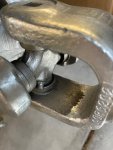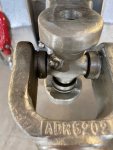A month ago, after about 4500 tow miles, I noticed that the McHitch on my D13 had some play, or wobble, in the shaft.
I didn't really notice any issue when towing, but it was concerning and obviously not operating as designed. Also, the play in the hitch was getting sloppier over time.
I contacted Caravan Specialties LLC (
mchitch.us). John was extremely helpful as always. He confirmed that there should be zero play in the system and that the hitch should not rotate freely. He also assured me that this should just be an adjustment issue, but if there was any damage to my hitch it would be covered under the McHitch warranty.
John explained that on rare occasions, he has seen the main nylock nut work its way loose over time. This is usually caused by the set screw in the nut not being properly tightened. As there is the large cotter pin on the shaft retaining the main nut, there is no concern with catastrophic failure.
John suggested that I disassemble the hitch to confirm no damage to the shaft or bushings. If no damage was found, all that would be needed is to lube and adjust per their 5-year maintenance procedure:
- Pull the main shaft cotter pin
- Remove the grub screw from the main nut
- Remove the nut and pull the shaft
- Wipe it off and clean the bushing flanges
- Even though the label on the McHitch states the graphite impregnated bushings do not require lubrication, John recommends smearing a coat of grease on the shaft and the bushing flanges. “Red-N-Tacky is a good grease, but any good chassis grease, or marine grease will work.”
- Re-install the shaft.
- Tighten the nut to 70 ft lbs. When it is at that value, the torque required to turn the main shaft in the body will be about 50-55 ft lbs.
- Install a new cotter pin
- Re-install the grub screw (set screw) with some medium (blue) Loctite on it. Do not put Loctite on the main nut threads
- Lube the u-joint just enough to see grease escape around the seals. This should be done once or twice a year
- Be sure the main yoke is clocked to where the small alignment pin is facing up as it enters the receiver.
I disassembled my McHitch and confirmed there was no damage. It was obvious that the main nut had backed off. Even though it is a Nylock nut, there was very little resistance to the nut turning once the grub screw was loosened. I followed the service procedure and everything is good. At the ~70 ft lbs of torque on the main nut, the torque required to rotate the main shaft is very close to the 50-55 ft lbs that John said to expect.
Based on this experience, here are my suggestions:
- Regularly check the main shaft on the McHitch when hitching or unhitching your trailer. There should be no play in the hitch and it should have a reasonable resistance to rotating.
- If your hitch shows signs of being loose, go ahead and adjust it.
- Remove the grub screw
- Tighten the main nut 70 ft lbs
- Reinstall the grub screw using medium Loctite and tighten securely
The main nut takes a 1-7/16” socket. I have not tried this, but if you don’t remove and replace the main cotter pin, you may be able to use a 12-inch Crescent wrench to adjust the main nut.
- If your hitch is not loose, I would still recommend removing the grub screw and reinstalling securely with Loctite.
- When you lubricate the u-joint
- Pump in grease until it just starts to squeeze out of the seals
- Rotate the u-joint back-and-forth on both axis to ensure the fresh grease is worked in
- Pump in a bit more grease. This ensures there are no air pockets in the u-joint.


